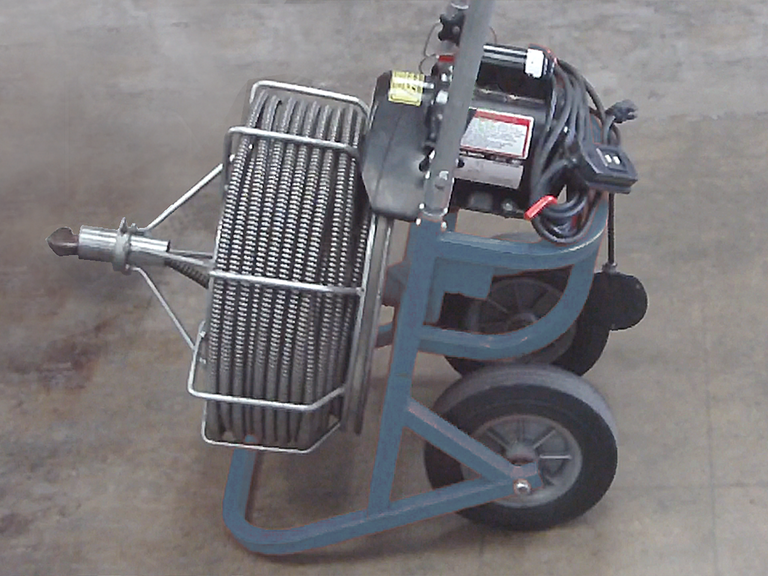
Motorized drain augers are the "rooters" used by rooter businesses. Also commonly called plumber's snakes, these powerful tools clear blocked plumbing by sending a flexibly stiff metal cable down drains and around the bends in the pipes—frequently extending hundreds of feet down the line from the access point.
The equipment used by the pros is a burlier and more powerful version of common household handheld drain spinners (for sinks and floor drains) and closet augers
(specially designed snakes for use on toilets). While these tools for use in the home are frequently worth their weight in saved money after their first use, some blockages are just too tough for them or out of their reach.
Motorized augers can handle these tougher jobs though. Electric motors or gasoline engines provide enough force and mechanical action to bore through the hardest gnarled intrusive tree roots. Even built up hard water mineral deposits will crumble to the grinding teeth at the head of the cable.
Do not use an overly powerful auger on damaged plumbing. Pre-existing cracks or weak spots are vulnerable to the considerable force delivered by the metal cable and grinding head. Undamaged pipes of all kinds are otherwise safe for use with an auger, including copper, PVC, concrete, and steel plumbing.
On the other hand, it can be a costly mistake to use an undersized drain auger. Drain snakes feed a corkscrewing cable down the plumbing. This cable is stiff enough to apply pressure to blockages, but flexible enough to make its way around corners in the pipes. If the auger cable is thin enough, and the diameter of the pipe large enough, it is possible for the cable to become knotted on itself inside the plumbing. When this happens, it most often means a costly repair, because the plumbing will have to be accessed to undo the knot before the auger can be removed.
To avoid tangling the cable, always use the proper tool for the drain. Handheld tools are designed for both typical basin and floor drains, or for use in toilets. Tools designed for use on toilets are referred to as closet augers, from the bathroom euphemism "water closet", and will have protected surfaces to avoid damaging commode porcelain, and wider diameter cable to avoid knotting in the wide drain.
Motorized drain snakes are for use on the larger pipes; most frequently the service laterals—pipes running away from a building to a main wastewater line near the street. These lines are meant to carry flow from the whole house and are usually four or more inches in interior diameter. The rooter professional will find an access point where they can gain entrance to the plumbing. These access point are outside in most modern homes, but can be found inside in basements as well.
From the access point, drain snakes can be extended all the way out to the utility main, cleaning and clearing any blockages or clogs in the way.
 General Pipe Cleaners Spin Thru Drain AugerStamped steel drum. 25-Foot cable capacity
General Pipe Cleaners Spin Thru Drain AugerStamped steel drum. 25-Foot cable capacity
 Video Snake Inspection SystemColor Monitor w/ Sun Shade. Color Camera w/ 8-deg. IR-LED Night Vision 60-deg. Field of View & 16" Focal Distance.
Video Snake Inspection SystemColor Monitor w/ Sun Shade. Color Camera w/ 8-deg. IR-LED Night Vision 60-deg. Field of View & 16" Focal Distance.
 Turbo Snake Drain Hair Removal ToolClear clogged bathroom sinks with ease using this tool seen on TV
Turbo Snake Drain Hair Removal ToolClear clogged bathroom sinks with ease using this tool seen on TV
Which Household Drain Problems Can Be Handled Without Calling A Pro?
UncloggingDrains101.comOne modern tool is a remote video camera, capable of inspecting plumbing from within and transmitting the image
UncloggingDrains101.comUsing powerful motorized drain snakes to grind and extract intrusive tree roots or other obstructions
UncloggingDrains101.comLearn about the latest technique for blasting clean clogged or blocked plumbing and pipes
UncloggingDrains101.comEverything about unclogging floor drains, from the toughest job to the quickest maintenance
UncloggingDrains101.comWhen clogs form in bathroom sinks, showers, bathtubs, kitchen & utility sinks, or shop & laundry drains—then the preferred tool will be a drain auger.
UncloggingDrains101.comWhich Household Drain Problems Can Be Handled Without Calling A Pro?
UncloggingDrains101.com